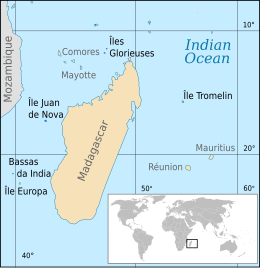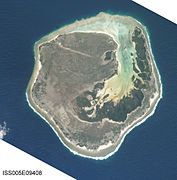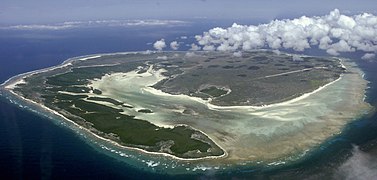You can help expand this article with text translated from the corresponding article in French. (November 2019) Click for important translation instructions.
|
| Europa IslandÎle Europa (French) | |
|---|---|
 Flag of the French Southern and Antarctic Lands
Flag of the French Southern and Antarctic Lands | |
| Motto: Liberté, égalité, fraternité | |
| Anthem: "La Marseillaise" |
| Disputed island | |
|---|---|
 Map of the Scattered Islands in the Indian Ocean (Europa Island in the southwest, marked by its French name Île Europa) Map of the Scattered Islands in the Indian Ocean (Europa Island in the southwest, marked by its French name Île Europa) | |
| Geography | |
| Location | Mozambique Channel |
| Coordinates | 22°22′S 40°22′E / 22.367°S 40.367°E / -22.367; 40.367 |
| Administration | |
| Overseas territory | French Southern and Antarctic Lands |
| District | Scattered Islands in the Indian Ocean |
| Claimed by | |
Europa Island (French: Île Europa, pronounced [il øʁɔpa]), in Malagasy Nosy Ampela is a 28-square-kilometre (11 sq mi) low-lying tropical atoll in the Mozambique Channel, about a third of the way from southern Madagascar to southern Mozambique. The island had never been inhabited until 1820, when the French family of Rosier moved to it. The island officially became a possession of France in 1897, though it is claimed by Madagascar.
The island, garrisoned by a detachment from Réunion, has a weather station and is visited by scientists. Though uninhabited now, it is part of the Scattered Islands of the French Southern and Antarctic Lands administrative region.
Europa Island was the setting of "Search in the Deep", a 1968 episode of The Undersea World of Jacques Cousteau, partly focusing on the breeding habits of the green sea turtle.
Description
Europa is 6 kilometres (3.7 mi) in diameter, with a maximum altitude of 6 metres (20 ft), and has 22.2 kilometres (13.8 mi) of coastline. It is surrounded by coral beaches and a fringing reef and encloses a mangrove lagoon of around 9 square kilometres (3.5 sq mi) and open to the sea on one side.
There are no ports or harbours but anchorage is possible offshore. Its exclusive economic zone, contiguous with that of Bassas da India, is 127,300 square kilometres (49,200 sq mi). The airstrip is 1,500 metres (4,920 ft) metres long.
Ecology
| Designations | |
|---|---|
| Ramsar Wetland | |
| Official name | Île d’Europa |
| Designated | 27 October 2011 |
| Reference no. | 2073 |
The island is a nature reserve. Its vegetation consists of dry forest, scrub, Euphorbia, the mangrove swamp, and the remains of a sisal plantation. It is one of the world's largest nesting sites for green sea turtles. It is also home to goats introduced by settlers in the late 18th century.
The island has been identified as an Important Bird Area by BirdLife International because it supports a large and diverse population of breeding seabirds and other waterbirds. It is the only known breeding site outside Aldabra and Madagascar for Malagasy pond herons. Seabirds include the second largest colony in the western Indian Ocean of great frigatebirds (with up to 1100 pairs), Audubon's shearwaters (up to 100 pairs, probably of the subspecies Puffinus lherminieri bailloni previously considered endemic to the Mascarene Islands), dimorphic egrets and Caspian terns.
Europa is home to an endemic subspecies of white-tailed tropicbird (Phaethon lepturus europae), three kinds of landbird (including an endemic subspecies of the Malagasy white-eye) and its own species of hissing cockroach.
Climate
Europa Island's climate is affected by the Agulhas Current with water temperatures usually above 30 °C (86 °F), southeast trade winds during the (austral) winter and occasional cyclones. The climate can be described as a semi-arid and tropical combination with wet summers and dry winters.
| Climate data for Europa Island | |||||||||||||
|---|---|---|---|---|---|---|---|---|---|---|---|---|---|
| Month | Jan | Feb | Mar | Apr | May | Jun | Jul | Aug | Sep | Oct | Nov | Dec | Year |
| Record high °C (°F) | 35.5 (95.9) |
34.4 (93.9) |
35.0 (95.0) |
32.4 (90.3) |
31.2 (88.2) |
29.2 (84.6) |
30.0 (86.0) |
29.4 (84.9) |
34.0 (93.2) |
33.7 (92.7) |
34.3 (93.7) |
33.4 (92.1) |
35.5 (95.9) |
| Mean daily maximum °C (°F) | 30.8 (87.4) |
31.2 (88.2) |
30.6 (87.1) |
29.2 (84.6) |
27.6 (81.7) |
26.1 (79.0) |
25.6 (78.1) |
26.2 (79.2) |
27.1 (80.8) |
28.4 (83.1) |
29.3 (84.7) |
30.2 (86.4) |
28.5 (83.3) |
| Daily mean °C (°F) | 27.5 (81.5) |
27.6 (81.7) |
27.0 (80.6) |
25.6 (78.1) |
23.5 (74.3) |
22.0 (71.6) |
21.6 (70.9) |
22.0 (71.6) |
22.7 (72.9) |
24.2 (75.6) |
25.3 (77.5) |
26.6 (79.9) |
24.7 (76.5) |
| Mean daily minimum °C (°F) | 24.1 (75.4) |
24.3 (75.7) |
23.6 (74.5) |
21.8 (71.2) |
19.7 (67.5) |
18.4 (65.1) |
17.7 (63.9) |
17.7 (63.9) |
18.7 (65.7) |
20.5 (68.9) |
21.8 (71.2) |
23.1 (73.6) |
20.9 (69.6) |
| Record low °C (°F) | 18.8 (65.8) |
19.1 (66.4) |
17.3 (63.1) |
15.6 (60.1) |
12.2 (54.0) |
10.2 (50.4) |
10.5 (50.9) |
11.1 (52.0) |
11.7 (53.1) |
12.4 (54.3) |
12.2 (54.0) |
15.0 (59.0) |
10.2 (50.4) |
| Average precipitation mm (inches) | 130 (5.1) |
104 (4.1) |
62 (2.4) |
28 (1.1) |
24 (0.9) |
18 (0.7) |
11 (0.4) |
10 (0.4) |
9 (0.4) |
7 (0.3) |
30 (1.2) |
129 (5.1) |
562 (22.1) |
| Average precipitation days (≥ 0.1 mm) | 10 | 8 | 8 | 5 | 5 | 5 | 4 | 3 | 3 | 2 | 4 | 9 | 65 |
| Average relative humidity (%) | 80 | 81 | 78 | 76 | 76 | 76 | 76 | 77 | 77 | 77 | 78 | 79 | 78 |
| Mean monthly sunshine hours | 275.9 | 257.1 | 275.9 | 255.0 | 272.8 | 246.0 | 263.5 | 288.3 | 276.0 | 300.7 | 291.0 | 272.8 | 3,275 |
| Mean daily sunshine hours | 8.9 | 9.1 | 8.9 | 8.5 | 8.8 | 8.2 | 8.5 | 9.3 | 9.2 | 9.7 | 9.7 | 8.8 | 9.0 |
| Source: Deutscher Wetterdienst | |||||||||||||
History
While the island has probably been sighted by navigators since at least the 16th century, it takes its name from the British ship Europa, which visited it in December 1774. Ruins and graves on Europa island attest to several attempts at settlement from the 1860s to the 1920s. For example, the French Rosiers family moved to the island in 1860, but subsequently abandoned it.
-
 Satellite photo of Europa Island (north at top)
Satellite photo of Europa Island (north at top)
-
 Map of Europa Island
Map of Europa Island
-
 Aerial view of the island
Aerial view of the island
-
 Beaches, north of the island
Beaches, north of the island
References
- "Le président Macron envoie l'Armée française sur les îles éparses". KoolSaina. July 27, 2021.
- "The Undersea World of Jacques Cousteau - Collection One". DocuWiki. 2013-11-10. Retrieved 2014-01-07.
- "Île d'Europa". Ramsar Sites Information Service. Retrieved 25 April 2018.
- BirdLife International. (2012). Important Bird Areas factsheet: Europa. Downloaded from "BirdLife International - conserving the world's birds". Archived from the original on 2007-07-10. Retrieved 2014-03-29. on 2012-01-07.
- C. van Herrewege. 1973. Contribution à l'étude des Blattaria de la faune Malgache. II. Description de huit espèces nouvelles appartenant aux genres Gromphadorhina Brunner v.W. et Elliptorhina gen. nov. Bulletin de la Société Linnéenne de Lyon, 42nd année, Numéro spécial du 150th anniversaire, décembre 1973. 75-103
- "Klimatafel von Europa (Insel), Iles Desirades / Indischer Ozean / Frankreich" (PDF). Baseline climate means (1961-1990) from stations all over the world (in German). Deutscher Wetterdienst. Retrieved 5 April 2017.
- "Europa". Districts - îles Eparses. Terres australes et antarctiques françaises. 2010. Archived from the original on 2012-01-31.
Further reading
- Warne, Kennedy (April 2014). "A tale of two atolls". National Geographic. pp. 62–75.
External links
 Media related to Europa Island (category) at Wikimedia Commons
Media related to Europa Island (category) at Wikimedia Commons
| Overseas France | |||||||||||||
|---|---|---|---|---|---|---|---|---|---|---|---|---|---|
| |||||||||||||
| |||||||||||||
| |||||||||||||
| Important Bird Areas of the French Southern Territories | |
|---|---|
| Amsterdam and Saint Paul Islands | |
| Crozet Islands | |
| Kerguelen Islands | |
| Scattered Islands | |
| Scattered Islands in the Indian Ocean | ||
|---|---|---|
- Mozambique Channel
- Indian Ocean atolls of France
- Atolls of Madagascar
- Uninhabited islands of France
- Uninhabited islands of Madagascar
- Disputed islands of Africa
- Territorial disputes of France
- Territorial disputes of Madagascar
- Islands of the French Southern and Antarctic Lands
- Important Bird Areas of the Scattered Islands in the Indian Ocean
- France–Madagascar relations
- Ramsar sites in France
- Seabird colonies